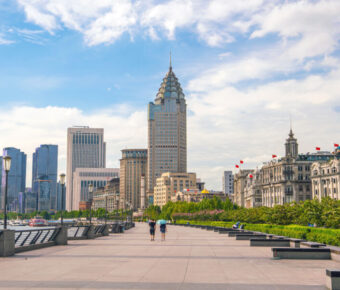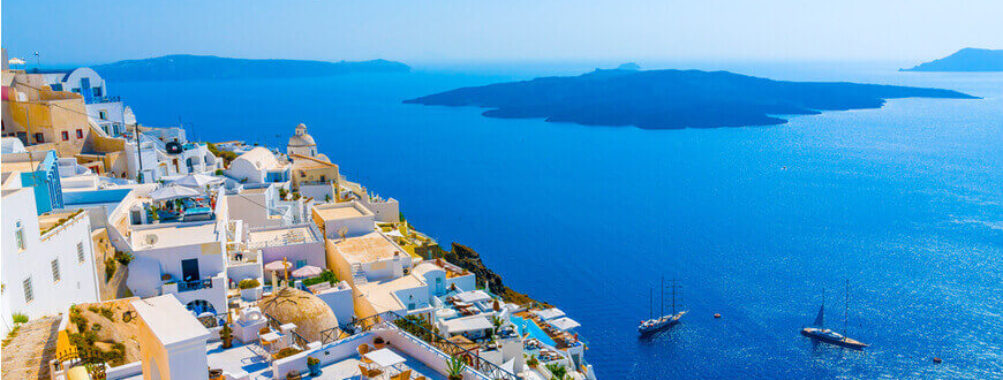
Best Time to Visit Santorini: Ultimate Guide for Perfect Weather and Fewer Crowds in 2025
Thinking about a trip to Santorini? Timing really matters on this gorgeous Greek island.
The crowds and prices can totally shift your experience on those famous white-washed cliffs overlooking the Aegean.
The best time to visit Santorini is during the shoulder seasons of late April to early June and September to early October when you’ll enjoy warm weather without the summer crowds. During these months, temperatures feel perfect for exploring, swimming is doable, and you can actually book those dreamy restaurants with caldera views.
Summer brings intense heat and a tidal wave of tourists, especially in July and August when cruise ships dock every day. Winter? It’s quiet and authentic, but a lot of businesses close and the weather can get chilly and sometimes rainy.
Contents
- Key Takeaways
- Understanding Santorini’s Climate and Seasons
- Overview of Santorini’s Weather Patterns
- Seasonal Temperature and Water Conditions
- How Weather Influences Travel Experiences
- High Season: Summer in Santorini
- Peak Season Activities and Atmosphere
- Nightlife and Vibrant Fira
- Santorini in Spring: A Local’s Favorite
- Mild Weather and Blooming Landscapes
- Spring Events and Local Festivals
- The Charm of Autumn in Santorini
- September and October: Warm Days, Relaxed Evenings
- Wine Tasting and Harvest Celebrations
- Exploring Santorini During the Shoulder Seasons
- Advantages of Fewer Crowds
- Benefits of Lower Prices
- Low Season and Winter: Unique Off-Season Experiences
- Winter Activities Beyond the Beaches
- Off-Season Travel Tips
- Top Activities by Season in Santorini
- Best Months for Hiking and Outdoor Adventures
- Sightseeing Hotspots by Season
- Frequently Asked Questions
- When is the peak tourist season in Santorini to plan a visit with minimal crowds?
- What months offer the best weather conditions for a honeymoon in Santorini?
- What months offer the best weather conditions for a honeymoon in Santorini?
- Which part of the year should travelers target for the most cost-effective trip to Santorini?
- Can you suggest when the local events and festivals in Santorini are in full swing for cultural immersion?
- In which season does Santorini experience its off-peak period for more serene exploration?
- Are there specific months when Santorini’s climate is ideal for sailing and beach activities?
- More Travel Guides
Key Takeaways
- Visit in May-June or September-October for ideal weather and fewer crowds
- Summer gives you the warmest temps but packed beaches and higher prices
- Spring means wildflowers, autumn brings perfect swimming and wine harvests
Understanding Santorini’s Climate and Seasons
Santorini’s weather really shapes your trip. The climate patterns decide how packed the beaches get and whether you’ll need a jacket for those caldera strolls at night.
Overview of Santorini’s Weather Patterns
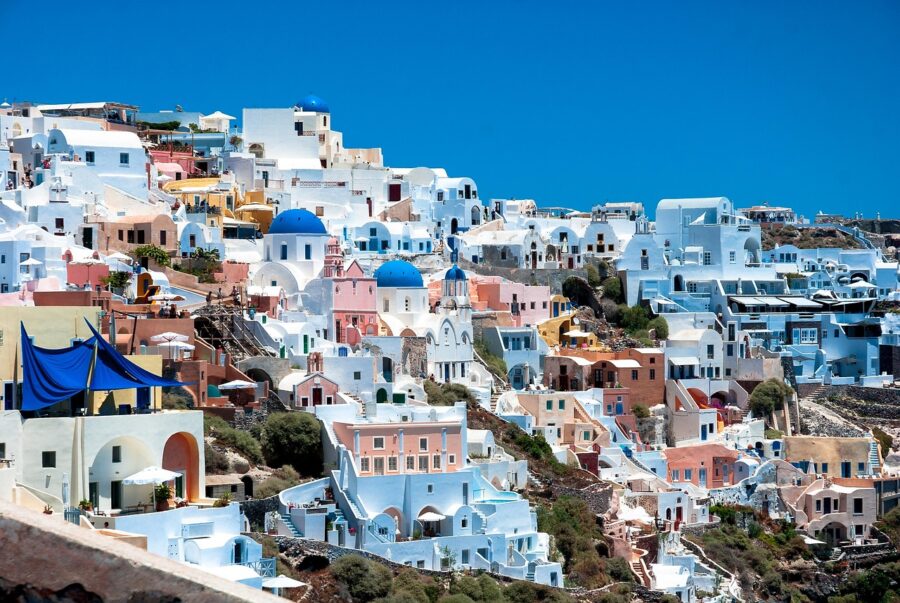
Santorini enjoys a classic Mediterranean climate with distinct seasons. Summers (June-August) are hot, dry, and almost rain-free—great for those blue-sky photos.
Temperatures usually sit between 75-85°F (24-29°C) in summer. Winters (December-February) are mild compared to northern Europe, but on this exposed island, it can get surprisingly chilly and windy.
You’ll get temps around 50-60°F (10-15°C) and more rain. Sometimes storms roll in and even disrupt the ferries.
Spring and fall are the sweet spot—pleasant weather and fewer tourists. Warm days, not much heat, and a peaceful vibe.
The island feels different, more relaxed, and you get more space at those popular viewpoints.
Seasonal Temperature and Water Conditions
By August, the sea warms up to 75-77°F (24-25°C), which is just about perfect for swimming at Perissa or Kamari. The water stays warm into October, so early fall swimming is still a thing.
In spring, water temps climb from 63°F (17°C) in April to about 70°F (21°C) by late May. It might feel brisk at first, but honestly, it’s refreshing.
Winter drops the water to 59-63°F (15-17°C). Locals think that’s too cold for swimming, but visitors from colder places sometimes hop in for a quick dip.
Santorini’s winds can get wild, especially the “meltemi” that blows from the north in summer. Sometimes they’re a relief from the heat, sometimes they mess with boat trips.
How Weather Influences Travel Experiences
Weather changes the whole Santorini vibe. Summer’s endless sun means great beach days and swimming, but you’ll share the island with crowds.
Restaurant reservations? Essential in high season. Prices spike too.
Spring (April-May) brings wildflowers everywhere, lighting up your hikes with color. It’s perfect for exploring archaeological sites like Ancient Akrotiri without melting.
Sunsets are still magical, and you won’t have to elbow your way to a good spot.
Fall (September-October) gives you warm days for sightseeing while the crowds thin out. The evening light is unreal for photos, and locals seem more relaxed after the summer rush.
Rainy days pop up in winter. The clouds over the caldera are dramatic and beautiful in their own way.
A lot of shops and restaurants close in winter, but if you visit, you’ll get a peek at the real Santorini.
High Season: Summer in Santorini
Summer turns Santorini into a buzzing paradise. From June through September, the island is packed with energy, but also with tourists and higher prices.
Peak Season Activities and Atmosphere
Summer days get hot—often 30°C (86°F) or more. Beaches like Red Beach and Kamari are packed, and every bar and restaurant seems to be running at full tilt.
If you want to sightsee, you’ll probably head out early or wait until late afternoon to dodge the strongest sun. Oia’s sunset viewpoints? They’re a zoo—people start staking out spots hours ahead.
Boat tours are everywhere in summer. The water is crystal clear, perfect for swimming and snorkeling around the volcanic islands.
A lot of tours stop at hot springs and hidden coves.
Nightlife and Vibrant Fira
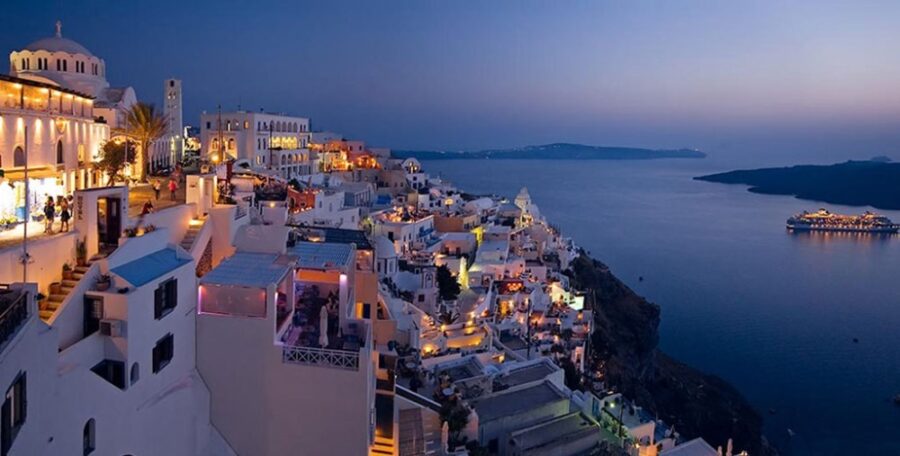
Fira, the capital, buzzes with nightlife in summer. Bars and clubs stay open until sunrise.
You can find everything from classy cocktail bars with caldera views to wild nightclubs with international DJs.
After dark, Fira’s narrow streets become a party zone. Restaurants stay open late, and the promenade fills up with performers and vendors.
It’s a scene—if you want to meet people and soak up the energy, you’ll love it.
Beach clubs in Perivolos and Perissa throw daytime parties that roll right into the night. Pool parties, live music, themed nights—there’s always something happening.
Drinks and cover charges at the hottest spots are pricey. Book tables in advance if you want to guarantee a good seat.
Santorini in Spring: A Local’s Favorite
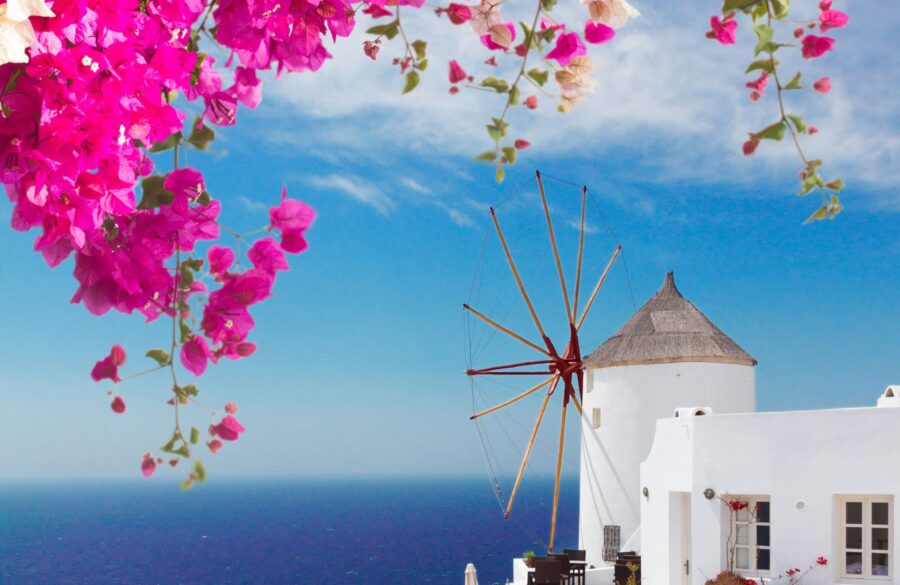
Spring brings out a side of Santorini that locals love. The island feels more genuine, less touristy, with manageable crowds and better prices.
Mild Weather and Blooming Landscapes
Spring temps hover between 15-25°C (59-77°F). You might need a jacket in April evenings, but May is usually warm and sunny.
You’ll get 8-10 hours of sunshine, so there’s plenty of time to explore without roasting.
What really sets spring apart? The wildflowers. Red poppies, yellow daisies, purple thyme—by late April and early May, the landscape explodes with color.
The beaches are peaceful. The water is chilly in April (about 17°C/63°F), but by May, it’s not bad for a quick swim.
Spring Events and Local Festivals
Spring wakes up Santorini’s cultural life. Greek Orthodox Easter (usually April or early May) is a huge deal—candlelit processions, midnight fireworks, and families roasting lamb.
The Santorini Wine Festival in mid-May is a treat if you like wine. Local wineries hold special tastings.
A few spring events worth checking out:
- Feast of St. Mark (April 25th) in Finikia
- May Day (May 1st) with flower wreaths and outdoor picnics
- Maritime Week (late May) features boat races and seafood festivals
Local tavernas reopen after winter, and the spring menus are full of fresh, just-picked ingredients.
The Charm of Autumn in Santorini
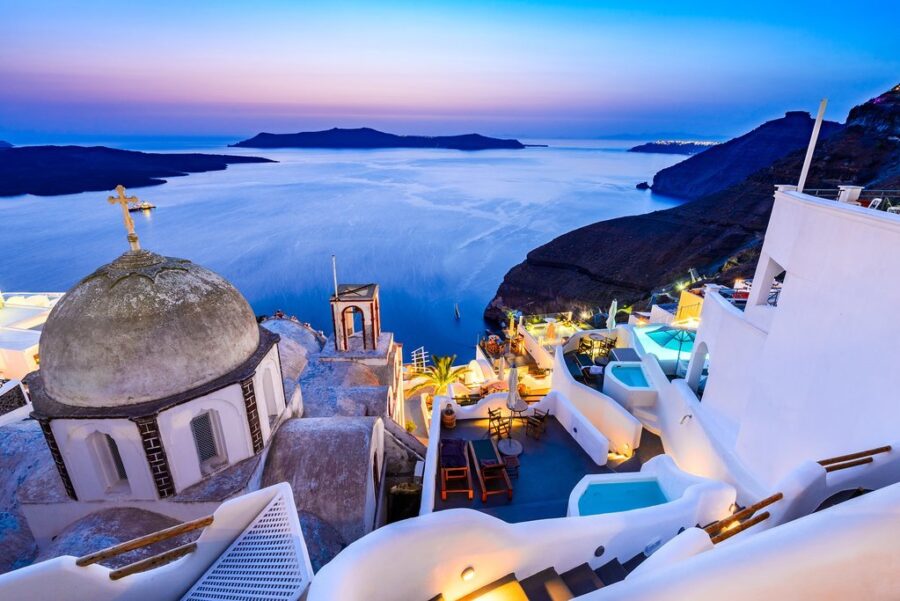
Autumn gives Santorini a whole new vibe. Warm days, relaxed pace, and way fewer crowds.
September and October: Warm Days, Relaxed Evenings
September feels like summer’s last hurrah. Temps stick between 20-25°C (68-77°F), so you can swim and sunbathe without melting.
The sea is still warm from summer.
October cools off a bit, with temps around 17-22°C (63-72°F), but it’s still great for exploring and beach days. Evenings call for a light jacket, which honestly feels kind of cozy when dining outdoors.
The best part? The crowds drop off. You can actually get a table at a popular restaurant with a sunset view.
Those iconic blue-domed church photos? You can finally snap them without a dozen people in the background.
Wine Tasting and Harvest Celebrations

Autumn is grape harvest season, so wine lovers should take note. Santorini’s volcanic soil makes for some pretty unique wines.
Wineries run special harvest tours in September and October. Some even let you join in on the grape picking.
The Assyrtiko grape, the island’s pride, peaks during this period.
Villages throw harvest festivals, so you get to mingle with locals and try fresh seasonal dishes paired with new wines.
Estate Argyros and Santo Wines offer fantastic tastings with caldera views—honestly, it’s even better without the summer crowds.
Try the fresh “must” (newly pressed grape juice) if you visit in autumn—it’s a sweet treat locals look forward to every year.
Exploring Santorini During the Shoulder Seasons
Shoulder season in Santorini is a game changer. April to early June and September to early November give you great weather and a more authentic island vibe.
Advantages of Fewer Crowds
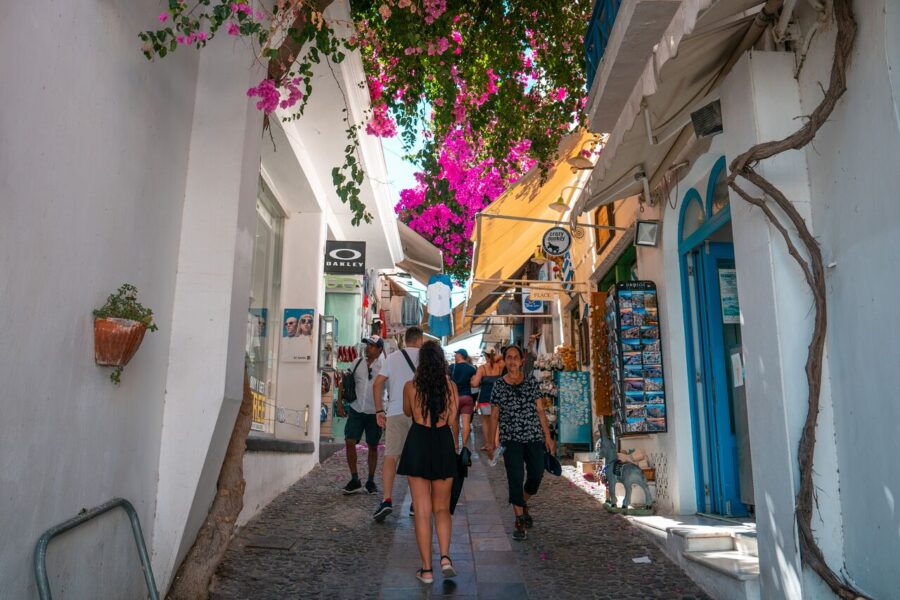
Exploring Santorini without the crowds? Absolute bliss. In March-May and September-November, you can actually see the famous blue-domed churches and Oia sunsets without fighting for space.
I’ve wandered Fira’s streets in October and had whole alleys to myself. It’s a different world compared to July.
Beaches are quieter too. You can stretch out without bumping elbows.
Restaurant reservations get easier. Sometimes you’ll snag a caldera-view table last minute.
Locals have more time to chat, and they’ll share insider tips you’d never hear in the summer rush.
Benefits of Lower Prices
Your wallet will be happier in shoulder season! Hotel rates can drop 30-50% compared to summer.
I’ve booked caldera-view rooms in May for what a basic hotel costs in August.
Flights also get cheaper, especially if you plan ahead.
Car rentals? Way more affordable. I once got a rental deal in November for half what friends paid in peak season.
Restaurants sometimes offer deals to lure in off-season guests. A free glass of wine or dessert isn’t unheard of.
Tour prices drop too. Whether you’re booking a catamaran cruise or a winery tour, expect better rates and smaller groups for more personal attention.
Low Season and Winter: Unique Off-Season Experiences
Visiting Santorini in the low season gives you a totally different experience. Fewer tourists, more genuine local interactions, and some surprises you won’t find in summer.
Winter Activities Beyond the Beaches
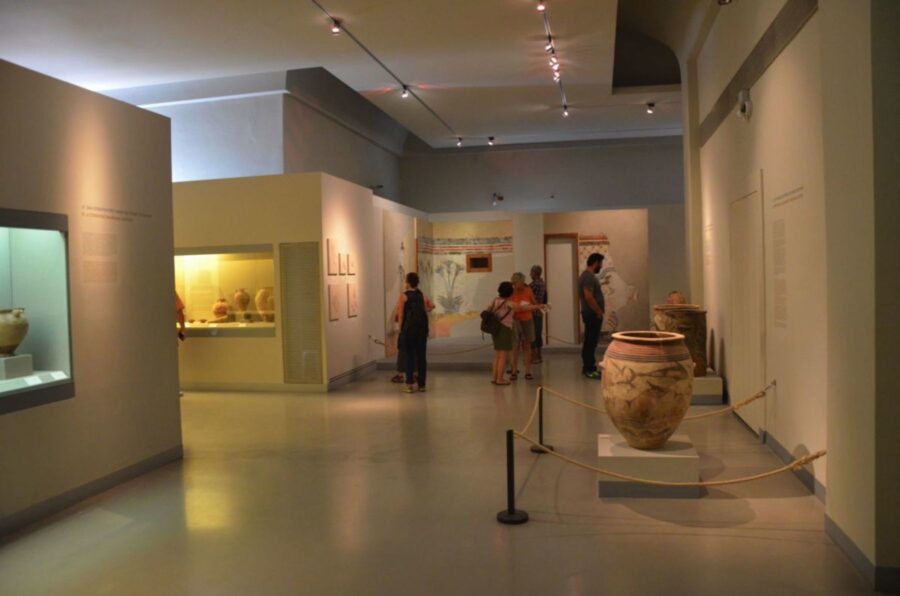
Santorini in winter? It’s underrated. Temps hover around 17°C (thanks, Reddit), and you’ll get plenty of sunny days for exploring.
Honestly, some of the best sunsets happen in winter, with dramatic skies over the caldera.
Museums and archaeological sites stay open and are blissfully empty. You can wander the ruins of Akrotiri or the Museum of Prehistoric Thera at your own pace.
The Archaeological Museum in Fira feels like your own private gallery.
Wine tasting in winter is more personal. Wineries stay open year-round, and the winemakers actually have time to chat.
Some offer special winter tastings you’ll never get in summer.
Try these winter activities:
- Photography tours (the clouds are wild for dramatic shots)
- Cooking classes with local ingredients
- Hiking the caldera path in cool, comfy weather
Off-Season Travel Tips
Pack layers! Days can feel pretty mild, but evenings get chilly fast.
You’ll want a light jacket, a scarf, and a sweater in your suitcase. Waterproof shoes? Don’t skip them—unexpected rain can sneak up on you.
Some restaurants and shops, especially in Oia, close up for winter. Fira, though, stays lively enough that you won’t go hungry.
Locals sometimes point you toward cozy tavernas that tourists often miss in the summer.
Accommodation prices drop dramatically—sometimes by 50-70% compared to peak season. Suddenly, that dream suite doesn’t seem so out of reach.
Transportation gets trickier in winter. Buses run less often, so renting a car can give you way more freedom.
Ferries also cut back their schedules, so double-check times if you’re planning to hop between islands.
Top Activities by Season in Santorini
Santorini always has something special going on, but what you’ll want to do really depends on the time of year.
Spring’s mild weather and summer’s buzz each bring out a different side of this wild island.
Best Months for Hiking and Outdoor Adventures
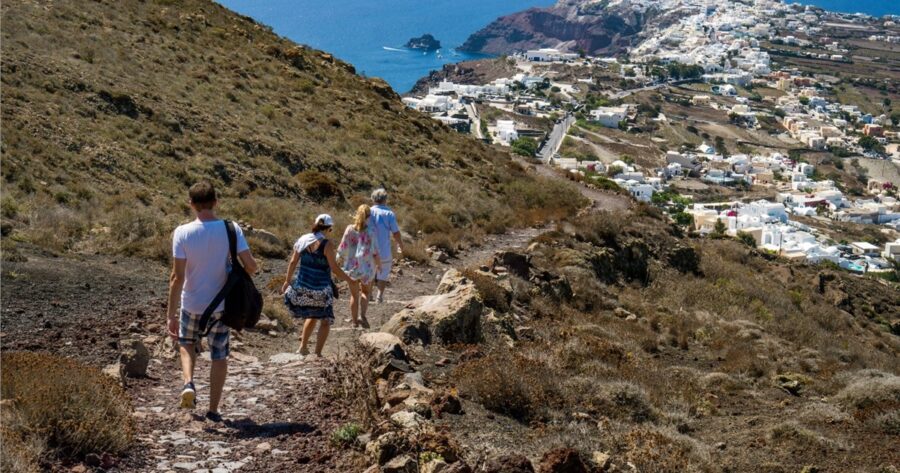
April to June and September to October are perfect for hiking in Santorini. Temperatures usually stay between 65-80°F, which makes it comfortable to wander outside without feeling roasted.
The famous Fira to Oia hike? It’s a must in spring, especially when wildflowers pop up along the caldera. That 6-mile trek treats you to the best views on the island and takes about 3-4 hours if you’re not rushing.
Skaros Rock, just by Imerovigli, feels like an adventure during these months. Climbing up to the medieval fortress ruins isn’t too hard, and the 360-degree views of the caldera and the Aegean are unreal.
Try to hit the trails early to dodge the afternoon sun—even in spring, it can catch you off guard. Bring water, sturdy shoes, and a hat; the Mediterranean sun packs a punch.
Sightseeing Hotspots by Season
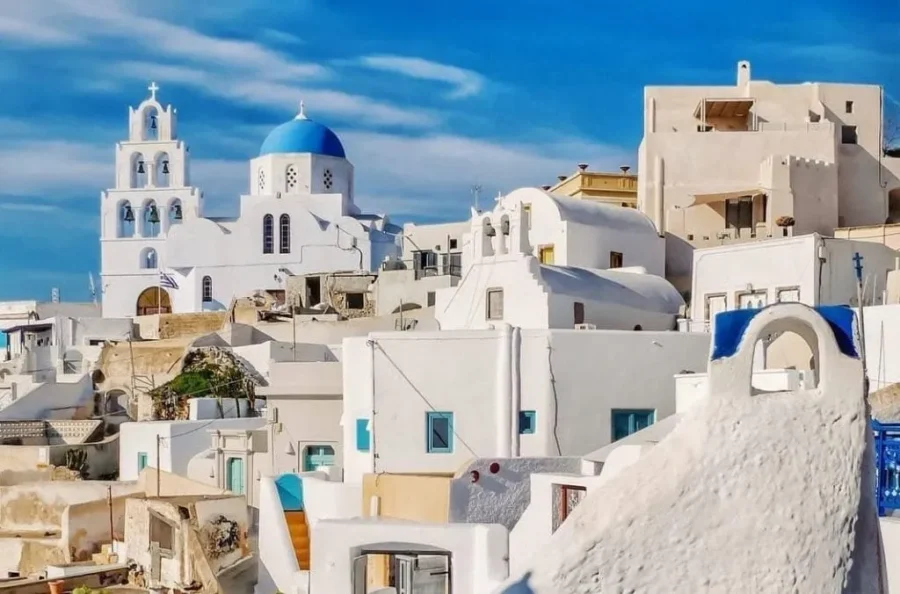
Summer (June-August) brings the biggest crowds to Santorini’s white villages. The vibe gets electric, but honestly, the sunset in Oia turns into a bit of a circus.
If you want a calmer sightseeing experience, spring and fall are the way to go. Some top spots:
- Ancient Akrotiri archaeological site
- Red Beach and Black Beach
- Wine tours in Megalochori
- Pyrgos traditional village
Winter (November-March) feels like a secret—fewer tourists, more local flavor. Major archaeological sites, like Ancient Thera up on Mesa Vouno, stay open and feel almost deserted.
Boat tours around the caldera? September and October are your sweet spot. The water’s still warm, but the crowds have faded.
Frequently Asked Questions
Trying to figure out the best time to visit Santorini? There’s a lot to juggle—crowds, weather, your wallet. People always want to know how to make the most of this stunning Greek island.
When is the peak tourist season in Santorini to plan a visit with minimal crowds?
July and August? That’s when Santorini is packed to the brim. It’s wall-to-wall visitors from everywhere.
If you’re hoping for some space to breathe, try May, early June, late September, or October. You’ll still get gorgeous weather, but you won’t have to elbow your way to the best views.
April and November are even quieter, though you might find some places closed or running on shorter hours.
What months offer the best weather conditions for a honeymoon in Santorini?
For a honeymoon, May through June and September through early October really shine. Those months usually bring warm, sunny days—just right for exploring or catching those famous sunsets.
Daytime temperatures usually sit between 70-80°F (21-27°C), so you won’t melt while wandering around.
Evenings feel perfect for dinner with a view, and the skies stay clearer than during the blazing summer.
What months offer the best weather conditions for a honeymoon in Santorini?
For a honeymoon, May through June and September through early October really shine. Those months usually bring warm, sunny days—just right for exploring or catching those famous sunsets.
Daytime temperatures usually sit between 70-80°F (21-27°C), so you won’t melt while wandering around.
Evenings feel perfect for dinner with a view, and the skies stay clearer than during the blazing summer.
Which part of the year should travelers target for the most cost-effective trip to Santorini?
If you’re after bargains, November through March is your window. Hotels often slash rates by 30-50% compared to summer.
April and October also offer good deals. The weather’s still decent, and you’ll pay less than in the high season.
Flights drop in price outside June-August too, which helps stretch your budget even further.
Can you suggest when the local events and festivals in Santorini are in full swing for cultural immersion?
Easter is huge in Santorini, usually in April or May. The whole island glows with candlelight processions, traditional food, and ceremonies.
August 15th brings the Feast of the Assumption—expect music, dancing, and tables loaded with special dishes.
The Ifestia Festival in September is wild: fireworks over the caldera, history, and spectacle all rolled into one.
In which season does Santorini experience its off-peak period for more serene exploration?
Santorini’s real off-peak season runs from November through March. The island feels almost tranquil, and you get a whole different vibe.
You can wander through Oia or Fira and barely see another tourist. It’s honestly kind of magical.
Some places run on shorter hours or close up, and ferries don’t run as often. But if you want a more authentic taste of island life, it’s worth it.
Are there specific months when Santorini’s climate is ideal for sailing and beach activities?
June through September brings the best conditions for beach activities and sailing around Santorini.
Water temperatures really warm up from July to September, usually hitting about 75°F (24°C).
The Meltemi winds, especially in July and August, can get pretty strong and shake up sailing conditions.
If you want calmer seas, early June or September tend to work out better for boat tours around the caldera.
May and October aren’t bad either for water activities, though the sea feels cooler.
The beaches stay enjoyable, especially if you catch one of those bright, sunny days that still pop up often during these months.


